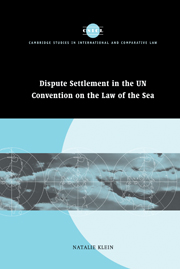Book contents
- Frontmatter
- Contents
- Acknowledgements
- List of Abbreviations
- Table of treaties and other international instruments
- Table of cases
- 1 Introduction
- 2 The Dispute Settlement Procedure under UNCLOS
- 3 Limitations on Applicability of Compulsory Procedures Entailing Binding Decisions
- 4 Optional Exceptions to Applicability of Compulsory Procedures Entailing Binding Decisions
- 5 Deep Seabed Mining
- 6 Conclusion
- Bibliography
- Index
- CAMBRIDGE STUDIES IN INTERNATIONAL AND COMPARATIVE LAW
2 - The Dispute Settlement Procedure under UNCLOS
Published online by Cambridge University Press: 04 July 2009
- Frontmatter
- Contents
- Acknowledgements
- List of Abbreviations
- Table of treaties and other international instruments
- Table of cases
- 1 Introduction
- 2 The Dispute Settlement Procedure under UNCLOS
- 3 Limitations on Applicability of Compulsory Procedures Entailing Binding Decisions
- 4 Optional Exceptions to Applicability of Compulsory Procedures Entailing Binding Decisions
- 5 Deep Seabed Mining
- 6 Conclusion
- Bibliography
- Index
- CAMBRIDGE STUDIES IN INTERNATIONAL AND COMPARATIVE LAW
Summary
Part XV of UNCLOS is a complex dispute settlement system that entails both traditional consent-based processes as well as mandatory procedures. In both respects, flexibility for States parties is a key feature. Section 1 of Part XV anticipates that States will pursue a range of dispute settlement options both within and outside the UNCLOS framework, reflecting that States have been accustomed to settling disputes in a variety of ways as those disputes arose and as demanded by the situation – not through predetermined means. Typically, diplomatic initiatives and negotiation have been the most efficient way to resolve a conflict. Resolution through political channels prior to judicial settlement is promoted in UNCLOS through the obligation to proceed expeditiously to an exchange of views when differences over the interpretation and application of the Convention emerge. States also retain the right to resolve conflicts through alternative (bilateral, regional, or general) agreements. This allowance was necessary in light of the large number of treaties that are specific to a particular issue area in the law of the sea and that incorporate their own dispute settlement systems.
Reliance is not entirely placed on consent-based methods of dispute resolution, however. The scope and complexity of UNCLOS as a constitutive instrument demanded procedural guarantees. For States to enjoy the benefits of the Convention, they simultaneously consent to binding and mandatory dispute resolution procedures.
- Type
- Chapter
- Information
- Publisher: Cambridge University PressPrint publication year: 2005
- 3
- Cited by



